Cunningham Book Review
by PETE on OCTOBER 10, 2013
Before me there are two massive volumes totaling 844 pages,
with over 1500 rarely-seen color and black and white photos. It is a classic
body of work that can’t be easily categorized, classified, analyzed,
compartmentalized, or even at times, comprehended. Unlike many books today, it
covers not just one serial number or marque, but multiple cars, events, and
drivers; the length, breadth, depth, and detail that define this opus are a
credit to both the subject matter and the author.
It would seem that such a huge work is necessary to reflect the life and times
of Briggs S. Cunningham II, and it is entitled, Cunningham: The Passion,
The Cars, The Legacy (aka CPCL). Hold that thought for now. 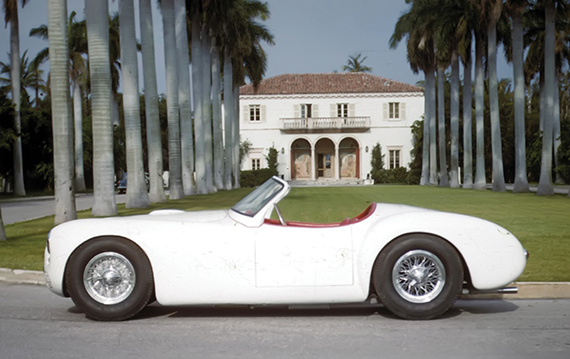
The Cunningham C-1 prototype in Palm Beach. Few men had the
passion, will and resources of Briggs S. Cunningham.
The Passion
To get this out of the way: If you are wondering if such an expensive ($350)
two volume set is a worthwhile purchase, consider that Richard Harman’s seven
year wonder is a massive work, encyclopedic in scope, and a thoroughly
well-researched foray into the history of the cars and events involved with
Briggs S. Cunningham II. Harman lists, explains, and details the ownership of
198 Cunningham-associated cars by serial number including all those which were
part of the Cunningham car collection. In addition to the Cunningham cars
themselves, Harman tells us about every car that Cunningham even breathed upon
or thought to purchase or allowed to be displayed in his museum in Costa Mesa;
every car that was handled by Momo or Team Cunningham, whether or not actually
owned by Briggs; every car that could conceivably be associated with the team
(such as a 3.4 Jag raced in England by Walt Hansgen, simply because he was on a
trip with Cunningham to the U.K.); virtually every car that Briggs bought on a
whim, and every car that he himself saved because he actually drove them; every
rare Italian car that caught Brigg’s eye, every Stanguellini, every Abarth,
every Ferrari, Maserati, Lancia, Alfa (pre and post war) and even a
Fiat-powered Formula Jr. Cooper (seems the BMC engines were unreliable and
replaced by a trusty Fiat 1100); even a Lancia Fulvia HF which he bought for
his second wife Laura to drive.
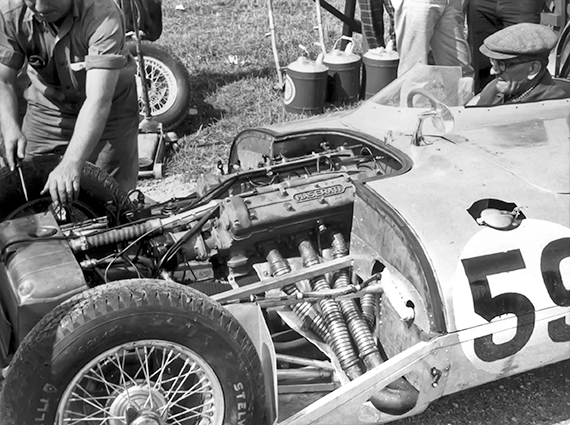
Momo's crew put a Fiat engine in a F Jr. Cooper and a Maserati
engine into a Lotus. Chapman didn't laugh.
In addition, the book covers every race event that a
Cunningham-owned or operated car took part in from 1938 to 1965.
There is a long chapter consisting of 67 briefs of various
lengths on every driver who ever drove for Cunningham, even if only once. These
short bios highlight a large number of drivers who are not widely known, as
well as the greats such as Moss and Gurney.
The structure of the book is somewhat clumsy but it works.
The problem is that since the author provides in-depth race reports in one
section, then follows that up with an in-depth history on each of the race cars
that participated in the event previously detailed, there is a certain amount
of repetition.
The Cars
CPCL is a huge work primarily because over a period of more than a half
century, Briggs Cunningham was able to buy whatever he pleased and did. Bruce
McLaren noted this habit firsthand while testing cars in Italy in 1962: “Briggs
really had a buying spree. Besides the T64 Maserati and the Cooper Monaco
Maserati, he bought a beautiful silver gray Maserati 5000 coupe. He also took
delivery of three 1000cc GT Abarths for the 3 hour race at Sebring and to top
up his shopping basket, added three special bodied Fiat 1500s ‘because he liked
the looks of them.’” (Ironically Harman does not mention the three Fiats in the
list of cars touched by Briggs.).
Harman of course has built much of his work on research
already done by Dalton Watson authors Willem Oosthoek, Walter Bäumer, and Terry
O’Neil, ferretting out the Cunningham race results, serial numbers, and
drivers. That in itself is amazing; Cunningham bought and raced MGs, Jags,
Mercedes, OSCAs, Listers, Jag D – Types and XKEs, Lotus, Coopers,
Stanguellinis, Abarths, Porsches, Maseratis, Ferraris, Cunninghams, Cadillacs,
Corvettes; a Siata, Healey Silverstone, Austin Healey, Aston Martin, Chrysler
Saratoga, Cooper Norton, and a Frazer-Nash from 1938 to 1965.
But what is also amazing is that Harman takes on tracking
the Jaguars, Porsches, Listers, and a host of other non-Italian marques by
serial numbers, including marque history and owners with equal ability and,
seemingly, accuracy. On the other hand he leaves himself open to corrections
from busy fact checkers who track everything from Abarth to Wills St. Claire.
All we can do is to peruse the French and Italian cars mentioned and as it is,
we found no serious errors, aside from labeling an Alfa Zagato as an Abarth 750
Zagato. Alas, we were too busy reading to do much fact checking.
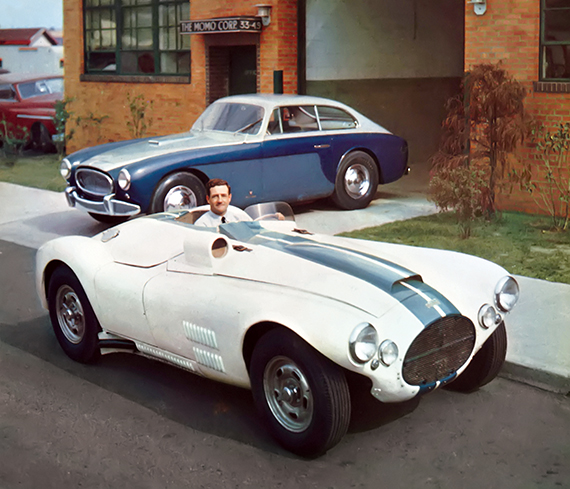
The man who could have been Enzo: Cunningham poses with the
awesome C4R and behind, a C-3 Vignale Gran Turismo coupe.
Aside from the huge amount of cars associated with the
Cunningham team and museum, there are the 47 actual Cunningham cars, each type
of which warrants its own chapter. From the C-1 to the last C6R, to the 25 odd
C-3 Vignale-bodied coupes and convertibles, each car is carefully investigated
and ownership and condition brought up to date. It was perhaps the most
interesting, and most vital part of the entire two volumes, and is worth a book
in itself. The Vignale bodies echoed the Ferraris of the same era, and were
very similar, as off the same buck. In fact, in 1968, someone had removed the
Cunningham badges from s/n 5224, replaced them with Ferrari badges and put it
up for auction; apparently it was the Cunningham that thought it was a Ferrari!
Briggs himself got involved, bid on the car successfully and had it restored
and shown at the Costa Mesa museum.
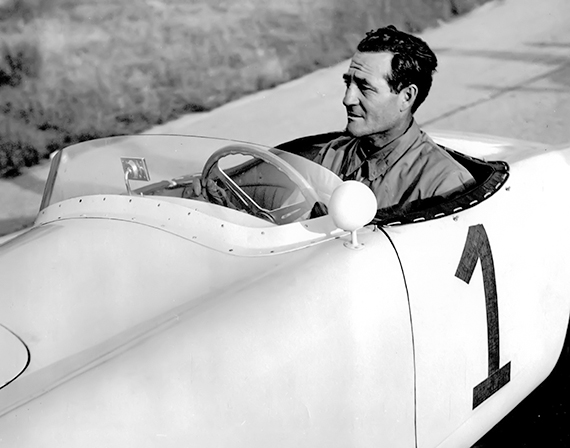
Briggs in the OSCA that won at Sebring in 1954; his favorite
car.
Briggs Cunningham owned, built, raced, drove or collected
the greatest cars of the 20th century. When asked which was his favorite car to
drive, he said, “Well, I always liked Ferraris, but I think the OSCA was my
favorite….it was beautifully finished, you know, nicely made.” That ought to
give our OSCA friends a bit of a boost!
The Legacy
We who basically grew up during the era of the Cunningham legend tend to take
him for granted, and perhaps that is why Harman, a Brit, was able to perceive
and record the tremendous influence Cunningham had on American racing. It was
huge, and in turn influenced British and European racing and constructors, if
only by funneling huge amounts of US dollars into the Jaguar and Maserati
factories after his own factory was closed in 1955.
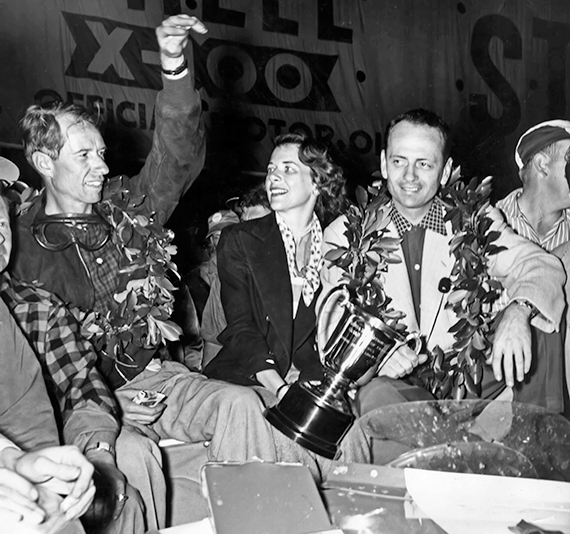
The two major drivers of the Cunningham C series, John Fitch
and Phil Walters celebrate victory at Sebring in 1953.
Which brings us to assess Cunningham from another
perspective. Almost single handedly, Cunningham created a world-class team of
cars capable of winning Le Mans. Cunningham never received any money from
Chrysler or any other American manufacturer, all tied up with the AAA ban on
racing and clearly uncomfortable with advertising racing victories. In this gracious
host, team player, race driver, gentleman, over-achiever, car constructor, flag
waver, America had a winner, and factory support (similar to that which Jaguar
offered Cunningham in the post 1955 era) would have perhaps changed the course
of American involvement in European racing. As it is, ten years, more or less,
went by before Ford finally decided to back a race team with the GT40 and
achieved Cunningham’s goal of winning at Le Mans. It took the extremely deep
pockets of the number 2 automaker to make this happen. Briggs was rich, but not
Ford-rich. Yet it was Briggs, not Ford, who deserved the win that would never
come his way.
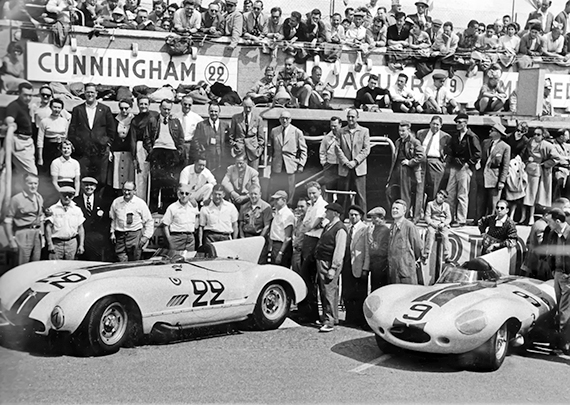
Le Mans, 1955. The last true Cunningham, the C6R, next to
the Cunningham entered D-Type Jag. It was the end of one era
and the beginning
of another. But think of what could have been.
We ponder what might have been, had Briggs not tossed in the
towel in 1955, at a time when international victories (he had won everything
Stateside) was just on the horizon. But Cunningham realized that the new 3
liter limit would hinder the effort as no American V8 was that small, and the
Offy, try as it might, just wasn’t cutting it. His cars weren’t selling that
well and cost too much to produce. Finally, the tax boondoggle came along; Cunningham
became a Jaguar distributor (Hoffman had had enough of the Jag’s unreliability)
establishing a profitable business, and began racing the D-Type Jags. It was a
successful partnership, but meant the end of an all-American race team. One
might wonder what would have been possible if instead of Jaguar, it was GM and
the new Corvette that came to the aid of the then beleaguered Cunningham
company.
Cunningham would continue to race at Le Mans and all over
the U.S., in a wide variety of classes from F Jr. to even running a Ford
Fairlane 500 in NASCAR events for Walt Hansgen. The team officially retired in
1963, but entered a few events until 1965. It was of course magnificently,
almost boringly, successful in U.S. racing.
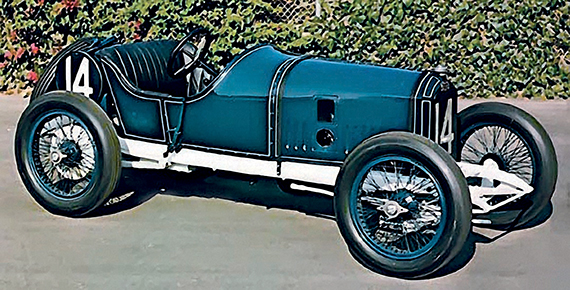
1913 Peugeot which placed second at Indy in 1914 was one of
the stars of the Cunningham Museum in Costa Mesa.
Author Richard Harman
chronicles the history and ownership of the Peugeot, as well as 198 others in
this his massive work.
By then Cunningham was 57, and was eager to open his new museum
in Costa Mesa, which came about in 1966. That lasted for twenty years, until
the majority of the Cunningham collection, some 77 cars, were purchased by the
Colliers in 1986 and moved to Naples, Florida, now the home of the REVS
institute as well.
For the Le Mans record; Briggs entered cars ten times,
placing cars in third twice, three fourth places, and one 5th, 7th, 8th and 9th
place. Briggs drove (Briggs was a superb long distance driver) in all ten races
and completed the full 24 hours in seven of them.
The Man
Back to that title, Cunningham: The Passion, The Cars, The Legacy. Notice
the lack of the normal “the man” in the subhead. Take it seriously. Harman is
not writing a biography here. Cunningham’s adventurous life until 1945 is
summed up in three pages. His post-1945 years become part and parcel of the
cars, racing, and collection that occupies the rest of the volumes. Personal
information is scarce. When Cunningham and his wife of 32 years parted, the
event is tersely put in one sentence: “During the year 1961, Briggs and his
wife Lucie were divorced.”
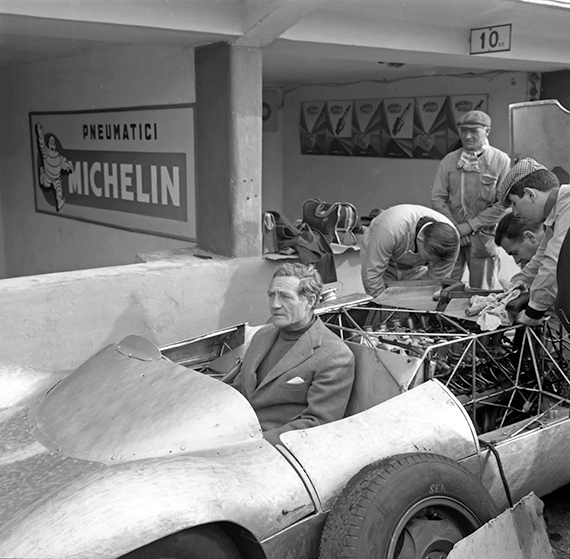
Usually photographed with a huge grin, Cunningham looks
worried during testing of the Maserati T64.
Through Harman’s chronicles, we learn a lot about the man
himself. But make no mistake; the biography of Briggs S. Cunningham has yet to
be written (and may never be). That does not mean to discredit the book or by
any means stop one from buying this magnificent opus…but it’s nice to know
beforehand.
The Book
The book has a great layout, clear with excellent photo reproduction and the
1500 photos are arranged nicely with the text. Par for the course for Dalton
Watson, recent books have had wonderful and totally complete indexes, so
necessary for a long work like this. There are many appendices, acknowledgements
and photo credits; a triple-A rating for the indexes and appendices. On the
downside, in the intro, Harman says there are credits for websites in the
acknowledgements but none are actually listed. There are photos that should
have been acknowledged but were not. The paper is glossy and of a heavy weight,
the binding is stitched and sturdy. Both volumes have dust jackets, but there
is no embossing on the cover. The slip cover is included and the entire set is
nicely boxed for shipping.
|